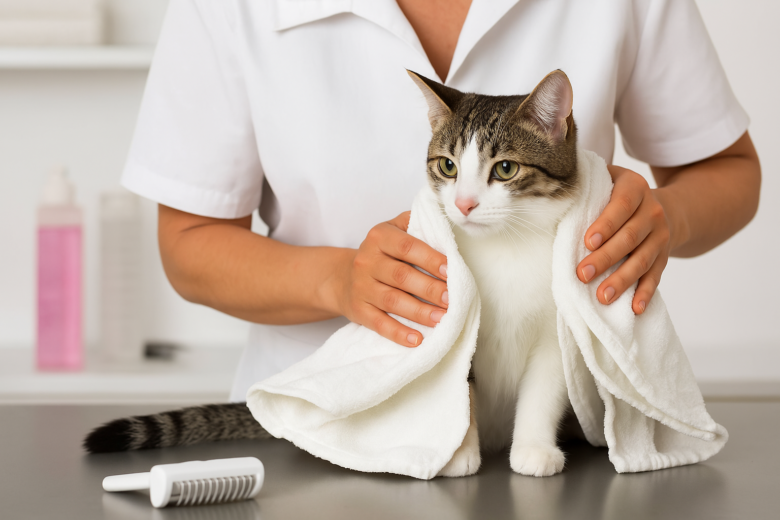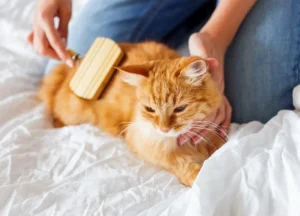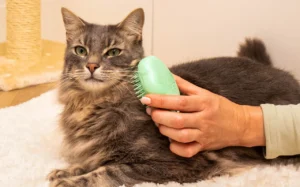Does your cat panic at the sight of water? You’re not alone. Most cats despise traditional baths, and trying to wash them often ends in scratches, stress, and frustration — for both of you. The good news? There’s a safe and effective alternative: the dry bath for cats. This method lets you clean your feline without turning on the faucet, keeping your pet calm and your hands scratch-free.
Why choose a dry bath for your cat?
Although cats are natural groomers, there are times when they need help — especially if they are older, overweight, recovering from surgery, or have gotten into something messy. A dry bath is a gentle, water-free way to keep your cat clean, fresh, and healthy without causing unnecessary anxiety.
Common situations where dry baths are useful:
- Senior cats: May not reach certain areas while grooming.
- Obese or arthritic cats: Have difficulty maintaining hygiene.
- After surgery: When water must be avoided around wounds.
- Dirty or smelly fur: From food, litter box accidents, or unknown messes.
Benefits of dry baths for cats
Dry baths offer a variety of benefits beyond avoiding water:
- Less stress: No loud water sounds or uncomfortable sensations.
- Quick and easy: No drying time needed afterward.
- Ideal for quick cleanups: Great for dirty paws or accidents.
- Improves coat health: Removes dirt and distributes natural oils.
What products to use for a dry cat bath
It’s essential to use grooming products specifically formulated for cats. Human products or baby wipes can contain ingredients that are toxic to cats. Below are safe and effective options:
1. Cat grooming wipes
Pre-moistened and ready to use, grooming wipes are perfect for daily maintenance or spot cleaning.
- Pros: Easy to use, travel-friendly, disposable
- Cons: Not ideal for deep cleaning or heavy soiling
2. Waterless foam shampoo
This rinse-free formula is massaged into the coat and then wiped away, removing dirt and odor.
- Pros: Full-body cleaning, gentle formulas available
- Cons: Some cats dislike the texture or scent
3. Dry shampoo powder for cats
Sprinkle the powder onto the fur, massage it in, and brush thoroughly to absorb oils and odor.
- Pros: Ideal for oily or long-haired coats
- Cons: Can be messy if over-applied
Step-by-step: how to give a dry bath to your cat
Step 1: Choose a calm moment
Wait until your cat is relaxed — after a meal or during nap time. Never attempt grooming when your cat is playful or agitated.
Step 2: Gather your tools
Prepare a soft brush, your dry grooming product (wipes, foam, or powder), a towel, and some treats.
Step 3: Introduce the product slowly
Let your cat sniff the product container or a small amount on your hand to build trust.
Step 4: Apply the product
- For wipes: Gently wipe your cat’s body, avoiding the eyes and ears.
- For foam: Apply a small amount to your hand, massage it into the fur, and towel-dry.
- For powder: Sprinkle on the coat, massage, and brush out thoroughly.
Step 5: Reward your cat
Offer praise or treats to create a positive experience. This builds a stress-free routine for future grooming sessions.
How often should you give a dry bath?
Frequency depends on your cat’s lifestyle and coat type:
- Indoor short-haired cats: Once or twice a month
- Long-haired cats: Weekly maintenance recommended
- Seniors or disabled cats: Every 7–10 days
- After accidents: As needed
Safety tips when using dry bath products
To protect your cat and make the experience pleasant:
- Avoid the face area: Never apply products near the eyes, nose, or ears.
- Check for reactions: Watch for redness, itching, or excessive grooming after application.
- Choose unscented or lightly scented products: Cats have sensitive noses and may dislike strong perfumes.
- Always test on a small patch first: Before using a new product, test it on a small area of your cat’s back.
Dry bath vs traditional bath: which is better?
It depends on the situation. Here’s a quick comparison:
| Feature | Dry Bath | Traditional Bath |
|---|---|---|
| Time required | 5–10 minutes | 20–40 minutes |
| Stress level | Low | High for most cats |
| Best for | Light cleaning, odor control | Heavy messes, fleas |
| Drying needed | No | Yes |
Conclusion: For regular grooming and odor control, dry baths are easier, safer, and less traumatic.
Signs that dry baths are working
Here’s how to know if your routine is effective:
- Shinier coat: Fur looks cleaner and feels softer
- Reduced odor: No unpleasant smells from the fur
- Calmer cat: Less resistance over time
- Less shedding: Especially when combined with brushing
Dry bath mistakes to avoid
Even with the best intentions, avoid these common pitfalls:
- Using baby wipes or human shampoo: These can be harmful to cats
- Skipping brushing: Brushing before and after ensures better results
- Overapplying product: A little goes a long way
- Ignoring reactions: If your cat shows discomfort, stop immediately
Can kittens have dry baths?
Yes, but with care. Only use products labeled safe for kittens and avoid strong scents or alcohol-based formulas. Use a soft cloth to apply product gently, and avoid the face area.
Final thoughts: Make grooming stress-free for you and your cat
If your cat fears water, a dry bath can be a game-changer. It helps maintain cleanliness, improves coat condition, and reduces household odors — all without the chaos of a traditional bath. With the right tools and a little patience, you can make grooming a regular, even enjoyable, part of your routine.
Ready to start? Choose a gentle dry shampoo or wipe and enjoy a calmer, cleaner cat today!
👉 Want to go further in grooming? Read our guide on the best brushes for cats to keep their coat tangle-free and healthy year-round.



